
Recently on Cyclingnews.com |
Yarns from the amateur peloton, June 13, 2007
Gran Fondo Dolomiti Stars - 2007
Spectacular Suffering
Italy loves the Giro d'Italia, where fans get to watch the stars suffer up the great climbs of the country. The same fans can experience a little bit of what the pro's encounter in the annual gran fondos - races that are open to everyone and anyone willing to subject themselves to a world class parcours. Cyclingnews' Ben Atkins traveled to Italy for the Gran Fondo Dolomiti Stars, and encountered spectacular views and spectacular suffering.
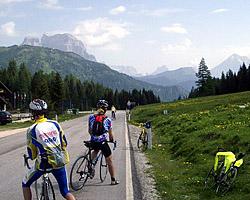
|
The Gran Fondo Giro d'Italia - Dolomiti Stars, to give it its full name, is part of a three race series based upon Italy's great races. The Challenge Gazzetta - conceived last year to celebrate 110 years of the eponymous pink paper (where the Giro's maglia rosa gets it's colour) - also includes medio fondos on the courses of the Milano-Sanremo and the Tour of Lombardy, but this is the big one!
The race gets its name from the Dolomiti Stars consortium, which was created to promote the four resorts of Ski Civetta, Falcade, Arabba and Marmolada in the mountainous Dolomite region in North West Italy. The various resorts have got together to raise awareness of their area internationally - both as winter and a summer destinations - situated as they are, just 100km to the north of Venice.
As part of their marketing strategy, the Dolomiti Stars have paid a lot of money to attract the Giro d'Italia to their area for a few stages, and to showcase the spectacular beauty of their region to us mortals, a gran fondo is organised in conjunction with the visit of Italy's number one race.
Locals are keen to emphasise that 70% of the Dolomiti are located in the Veneto region - mostly in the Belluno province - and many of them feel a bit aggrieved that the neighbouring, semi-autonomous region of Trentino-Alto Adige is often credited with scenery that doesn't belong to them.
"Not only were the sadists going to make me ride up this thing, they were also going to tell me and everyone else how slowly I did it!"-Ben gets timed on his ascent up the Passo Giau. |
This year's Gran Fondo course was to take in a 135km circuit starting and finishing in the town of Arabba (1602m) and would take in the four mountain passes of the Passo Duran (1601m), the Passo Staulanza (1773m) the Passo di Giau (2232m), and the Passo Falzarego (2105m).
Unfortunately, I haven't scaled anything resembling a mountain pass since August 2005, and having not done anything that could be called training - in fact very little that could be called riding - since my daughter Isabel was born a month ago. This was going to be a bit of a challenge. My pretty woeful climbing legs were going to get a pretty fearsome test - but hey, it's only 135km, how hard can it be?
The thing with gran fondi, is that the guys at the front of the race - riding to win - are not a great deal lower in standard than the pros. In fact, I've been 'beaten' on more than one occasion by former Tour de France podium boy Raimundas Rumsas, so the people at the finish line are geared up to receive the winner a long time before I turn up. I don't fear the climbs - I can climb all day (that's how long it takes sometimes!) - but what I do fear is the broom wagon. I can get up most climbs, and round most courses, but I'm never sure that there's going to be anyone there when I get to the finish!
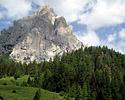
|
I arrived in Arabba just in time the night before to collect my race number, timing chip and Paco Gara - a race pack which is an integral part of all gran fondi these days. It generally consists of merchandise samples from the various sponsors and one or more 'gadgets'. In this case, on top of the samples I got a pair of Dolomiti Stars socks, a pair of Challenge Gazzetta leg warmers, and - get this - a commemorative bike bag! The pack also contains a route profile (thanks!) and most importantly vouchers for pasta, coffee and especially beer for after the 'race'.
Normally I would advise arriving a lot earlier than this to give yourself a chance to get accustomed to the area, to have a quick spin to warm your legs up, or just to get extra rest, but I'd been collecting my test bike from Cicli Battaglin in Marostica, a two hour drive south. I had ended up watching the Giro there in the presence of Giovanni Battaglin, the 1981 winner, and he'd been able to impart lots of advice and experience on the challenge I had ahead. Most importantly, he'd been able to fit a compact crank set and a 12-26 cassette on the bike!
After a good carbo-loading dinner, followed by the best night's sleep I've had since Isabel was born, I lined up with eleven hundred other amateur hopefuls for the 8am start. I was honoured to be given the bib number 5, as a guest of the organisers, which meant I was entitled to start in the front grid with the top riders and the VIPs. But I already had the feeling of having bitten off more than I could chew, so I didn't want to push things too much. I found myself a space about two thirds back and listened to the announcer count us down to the start.
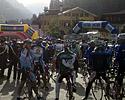
|
As the race got under way we slowly filtered our way over the timing mat - to register that we'd started - and began the long gradual descent to the start of the first climb of the day. Arabba is nestled comfortably at the foot of the Passos Campolongo and Pordoi, but we were going the other way towards Agordo, where Stage 16 of the Giro would start the following Tuesday, to an area near where the Passo Duran begins.
As Arabba is actually slightly higher than the Passo Duran, we had a lot of altitude to lose and the course sloped steadily downwards for the first 38km. I managed to get myself into some good groups - until I found them too slow and moved ahead with some like minded others (ah, gravity my old friend!). We managed a pretty healthy pace until we arrived at the town of Caprile, the point of no return where the two courses divide.
It's at this point where you can often get a nasty shock. It's been known to happen that riders are flying along at what they feel is a comfortable pace, with a group that they feel are a good level to stick with, only to see them all turn on to the shorter course to leave them to tackle the long one alone. Thankfully, this didn't happen to me, and most of the group I was with seemed to carry straight on in the same direction as me, and we reassembled ourselves for the remainder of this fast initial part.

|
Another slight quirk of this gran fondo course compared to others is that the gran and medio courses divide so early. Normally, you get a chance to see how your form is on the first climb before deciding whether or not to take on the biggie, but here there was no such luxury. Once you'd taken the decision to go straight on at this point there was absolutely no going back!
After about an hour of descending and fast downward false flats we arrived at the day's first obstacle, and my first assault on a mountain pass for nearly two years - the Passo Duran. This is not one of those passes that breaks you in gently, as soon as the climb started and the grade became steeper, I found myself hurriedly clicking my way down through the gears.
Lots of riders - those that I'd managed to leave behind me on that long descent - began to slowly trickle past me as my friend gravity turned against me and my lack of recent mountain climbing began to show. It didn't seem worth trying to up my pace at this stage though, I was in this for the long haul and this was the first of four passes. I didn't want to blow myself up this early on - especially as I haven't done this for quite a while.
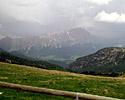
|
By now the heat of the day was beginning to set in. As 9am became 10am, the sun got higher and higher in the sky and threatened to punish me for the other thing I've had a lack of this year - sunshine! I don't generally bare my knees until after Easter and have hardly ridden since then. With my armwarmers well and truly rolled down, the sun beat down unrelentingly on my pasty white arms and legs. Luckily for me and my delicate lilywhite British skin, the Passo Duran is 'only' 13km long and so after only about an hour I reached the top and helped myself to several drinks and cakes at the official ristoro there.
The descent turned out to be not too technical, and the roads were dry and pretty wide, so while the sun was still shining, the speed still called for my armwarmers to be rolled back up and for my gilet to be fully zipped up. The main danger here - as I've found before - is from looking at the view too much. From this altitude the whole area is absolutely breathtaking - ranging from lush green valleys and alpine meadows to huge lumps of the pink rock that make the Dolomites so recognisable. These rocs are actually coral! Yes, these mountains used to be underwater like some prehistoric Great Barrier Reef! Not for the first time in my descending career, I had to remind myself to keep my eyes on the road, and my mind on the job in hand.
I experienced more of the same on the slightly shorter, but no easier climb of the Passo Staulanza. I eventually reached the top and once again charged my bottles, stuffed my face, zipped myself up and pointed myself downwards. I was getting nervous now - those first two climbs had been tough, but were pretty small compared to what was coming next - the Passo Giau. It's 'only' 11km long, but it averages a nasty 9.8% and has bits that are up to 14%.
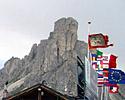
|
All too soon I reached the bottom of this beast. I knew the climb was starting because I had to roll over a timing mat first. Not only were the sadists going to make me ride up this thing, they were also going to tell me and everyone else how slowly I did it!
The first few kilometres were pretty sheltered, and wound their way through a narrow valley... oh, and they're also really steep.
Thankfully the weather had decided to change, because if it had been as hot on this climb as it had on the first two it would have been almost unbearably tough. As it was though, the riders at the head of the field had been rained on pretty hard and even experienced hailstorms, but thankfully we just had some intermittent drizzle and overcast skies to deal with, and the rain certainly made things a lot more comfortable.
After a few kilometres the climb opened up, and by looking over to the right or left the whole spectacular valley was there in all its glory. This amazing panorama became a pretty useful distraction as I ground my way up the steep ramps and hairpins. It also helped me to avoid looking up too often, as this part of the climb is so open that you can see the steepness of every section as it rises above you.
One of the problems of climbing these passes is that when you look up to the next straight as it rises from the hairpin in front of you, it always looks twice as steep as it actually is. If you're currently climbing a ramp of 8% and the next one is also 8%, it looks from you point of view as though it is 16%. This can be really demoralising, even when you know this fact, so it's best not to look up at all - just concentrate on the view!

|
As the climb opened up more I was reminded of what was happening here tomorrow - why this gran fond was on a Saturday when they're generally on Sundays. The Giro would climb the Giau the next day on its way to Tre Cime di Laveredo, and as usual plenty of people had come out to reserve their spot early. Cars, but mostly camper vans were now squeezed onto every available semi-flat piece of ground at the side of the road. Many of their owners - like the Belgians at Paris-Roubaix - obviously not believing in leaving everything to the last minute, were already in a pretty good state of inebriation.
This is one of the great things about riding an event that is attached to such a prestigious race. Just as the fans in Geraardsbergen line the Muur and cheer for the cycletourists, the fans who came for the Giro were just as vocal for me. I turned down countless offers of pushes (that old 'I must do this myself!' cliché) and a few offers of beers (later!) and cracked such a smile for the photographer at the top that it made my face hurt - I couldn't help it! I've never been 2232m high before without being on a plane, so while I was a bit late for the gran fondo's official Cima Coppi, I awarded myself a personal one.
After eating and drinking as much as possible - and wiping the painful smile off my face - I started the long spectacular descent down the other side. As the Giro was coming over, they'd been out with the tarmacking machine in several areas, and part of it was wet from the earlier rain so I took it fairly easy. Anyhow, I'd just spent an hour and twenty minutes climbing so I wasn't in any hurry for the road to start rising again!
Before too long though, the course took the left turn - away from Cortina d'Ampezzo where the Giro would go - towards the Passo Falzarego. I reminded myself of what Giovanni Battaglin had said yesterday about the climb being niente in this direction, I certainly hoped so - my legs were cooked! He was right, of course, but even the false flats that made up the middle part of the climb seemed to be too much for me to do anything more than maintain some kind of forward motion. The Giau seemed to have taken more out of me than I thought.
After what seemed like a very long time, I reached the spectacular summit, and apart from the gentle drag back to Arabba, the end of the day's climbing. I still seemed to have plenty of food and drink on me, so I shunned the ristoro and made my way down the other side.
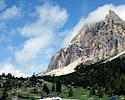
|
Here was where I understood what Battaglin had meant - the climb was pretty much nothing from the other side, but this side was really steep. Thankfully though, the surface was pretty good, the roads were wide and most of it was nice and open. The only scary bit really was a short unlit tunnel that contained a right angle bend, but it was well sign-posted so I took it slowly and managed to get out the other side okay.
From the bottom of the Falzarego there was just the simple matter of the ten kilometres or so back to Arabba on the roads that we'd all descended this morning. I wasn't looking forward to this as the profile showed it to be a bit of a drag, but fortunately, apart from a few sections that were definitely uphill, it appeared to be predominantly flat, or even downhill in some places. No wonder I hadn't felt good this morning and couldn't work out how come my heart rate was so high on a descent - we were going uphill half the time!
The last kilometre or so was definitely uphill though, and the last hundred metres was something of a sharp ramp - a good finish for a Bettini type, I thought as I did my best to muster some kind of sprint for the few people that were still at the barriers. The good news was, that I finished before they let the inflatables down! I wasn't last either, although having taken almost three hours longer than the winner I wasn't far off it. If I'd done the shorter course maybe I could have got a respectable finishing position, but where would be the fun in that?
This was definitely one of the toughest gran fondos I've done. More than 3500m climbed in only 135km makes for a pretty extreme course, but some of the views I'd seen, not to mention the kudos of climbs like the Giau definitely puts it in my calendar for next year. Maybe Isabel will let me train for it!
Photography
For a thumbnail gallery of these images, click here
Images by Ben Atkins/Cyclingnews.com
- The spectacularly picturesque town of Arabba nestled comfortably at the foot of the Passos Pordoi and Campolongo
- You know it's going to be a good day when you wake up to a view like this out of your hotel room window!
- And this is what I see when I look the other way!
- The sun's not been up all that long but the Gran Fondo Giro d'Italia - Dolomiti Stars is ready to go
- Riders chat nervously as we await the start
- The beautiful Dolomiti look on as the start approaches
- The Passo Duran I looked for Simon le Bon but he wasn't there (sorry, eighties joke!)
- The view down the other side of the Passo Duran
- A massive piece of pink rock (coral!) overlooks the Passo Staulanza
- The Passo Giau. This bar is busier than usual today!
- Massed Camper Vans especially to see me ride by (oh, and they're waiting for tomorrow's Giro stage)
- Wow! I just climbed up from down there!
- The spectacular scenery of the Passo Falzarego "niente" form the side thatI climbed it (but not when you've just done the Giau!)
- Scenery like this can help keep your mind off the pain in your legs (and back, arms, head, feet, hands etc etc!)
